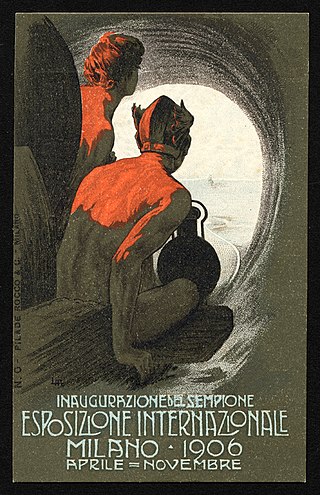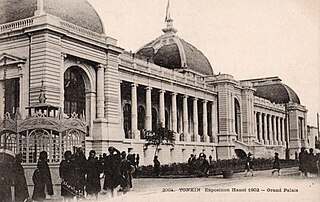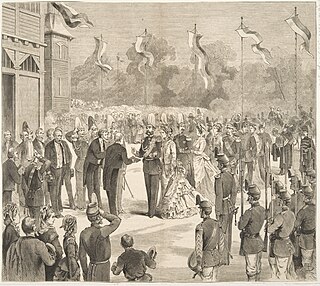
The Exposition Universelle of 1855, better known in English as the 1855 Paris Exposition, was a world's fair held on the Champs-Élysées in Paris, France, from 15 May to 15 November 1855. Its full official title was the Exposition Universelle des produits de l'Agriculture, de l'Industrie et des Beaux-Arts de Paris 1855. It was the first of ten major expositions held in the city between 1855 and 1937. Nowadays, the exposition's sole physical remnant is the Théâtre du Rond-Point des Champs-Élysées, designed by architect Gabriel Davioud, which originally housed the Panorama National.

Expo '98 was an official specialised World's Fair held in Lisbon, Portugal from Friday, 22 May to Wednesday, 30 September 1998. The theme of the fair was "The Oceans, a Heritage for the Future", chosen in part to commemorate 500 years of Portuguese discoveries. The Expo received over 10 million visitors in 132 days, while 143 countries and many organizations were represented.

The Melbourne International Exhibition is the eighth World's fair officially recognised by the Bureau International des Expositions (BIE) and the first official World's Fair in the Southern Hemisphere.

The Prima Esposizione Internazionale d'Arte Decorativa Moderna, held in Turin, Italy in 1902, was a world arts exhibition that was important in spreading the popularity of Art Nouveau design, especially to Italy. Its aim was explicitly modern: "Only original products that show a decisive tendency toward aesthetic renewal of form will be admitted. Neither mere imitations of past styles nor industrial products not inspired by an artistic sense will be accepted."

The Iveagh Gardens is a public park located between Clonmel Street and Upper Hatch Street, near the National Concert Hall in Dublin, Ireland. It is a national, as opposed to a municipal park, and designated as a National Historic Property. The gardens are almost completely surrounded by buildings making them less noticeable and a little hard to find, unlike other green spaces in Dublin.

The Irish International Exhibition was a world's fair held in Dublin in 1907, when all of Ireland was still part of the United Kingdom.

The Liège International Exposition was a world's fair held in Liège, Belgium, from 27 April to 6 November 1905 just 8 years after a Belgian exposition held in Brussels. Intended to show Liège's industrial importance it also marked 75 years of Belgian Independence and 40 years of Leopold II's reign.

The Antwerp International Exposition was a world's fair held in Antwerp, Belgium, between 5 May and 5 November 1894. It covered 65.5 acres (265,000 m2), attracted 3 million visits and made a profit. It took place at the same location as the 1885 exposition.

The Glasgow International Exhibition was the second of 4 international exhibitions held in Glasgow, Scotland during the late 19th and early 20th centuries. The exhibition took place during a period of half-mourning requested by Edward VII but was still popular and made more than £35000 profit. The exhibition was opened by the King's daughter, the Princess Louise, Duchess of Fife.

The 1888 Barcelona Universal Exposition was Spain's first International World's Fair and ran from 8 April to 9 December 1888. It was also the first of the two held in Barcelona.

The Milan International was a world's fair held in Milan in 1906 titled L'Esposizione Internazionale del Sempione, or sometimes The Great Expo of Work. It received 4,012,776 visits and covered 250 acres.

The Antwerp International Exposition was a world's fair held in Antwerp, Belgium, between 2 May and 2 November 1885. It covered 54.3 acres (220,000 m2), attracted 3.5 million visits and broke even after spending 4 million Belgian francs There were 25 official participating nations including: Austria, Canada, France, Germany, Great Britain, the Ottoman Empire, Portugal, Serbia, Spain, Romania, the United States and some South American states. Australian wool growers sent exhibitions and won prizes.

The Irish Industrial Exhibition was a world's fair held in Cork in 1852, the first to be held in Ireland. It was opened on 10 June by the Lord Lieutenant, the Earl of Eglinton.

The Exposition internationale du bicentenaire de Port-au-Prince was a world's fair held in Port-au-Prince, Haiti in 1949 to mark the 200th anniversary of the city's founding.

The Hanoi Exhibition was a world's fair held in Hanoi in then French Indochina between November 16, 1902, and February 15 or 16, 1903.
The Calcutta International Exhibition world's fair was held in Calcutta from the end of 1883 to March 1884.

The South African International Exhibition held in Cape Town, Cape Colony was a world's fair held in 1877 which opened on 15 February by Henry Bartle Frere.

The New Zealand Exhibition, which took place in Dunedin, New Zealand, in 1865, was a world's fair visited by approximately 31250 people. It was the first world's fair held in New Zealand. It opened on 12 January and ran until 6 May 1865.

The first Finnish Universal Exhibition was held in Helsinki in 1876. the exhibition had been suggested in 1868, but was impacted by the great famine.



















